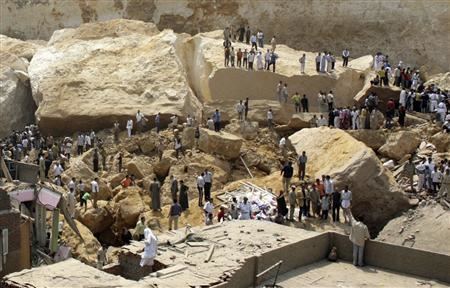Start date September 6, 2008 | ||
 | ||
Similar 2007 Chittagong mudslides, Tuve landslide, Val Pola landslide, 1997 Thredbo landslide, Frank Slide | ||
2008 cairo landslide
A horrible tragedy happened in Cairo one evening. Referred to as The 2008 Cairo landslide, on September 6, 2008, at el-Deweika, an informal settlement in the Manshiyat Naser neighborhood of east Cairo, Egypt, 119 people died in the rockslide. Some people blamed for the tragedy were arrested and held accountable.
Boulders weighing as much as 70 tons rolled into the shantytown following the landslide. After most of the neighborhood had been flattened, those families still living in the slum were evicted and any remaining buildings were flattened by the government. As a result, hundreds of families were left homeless and many still live in squalor near the site of the disaster, despite government promises to find them homes.
The cause of the landslide has not been definitively determined, but theories included leaked sewage from development projects that eroded rocks. An internal investigation determined that the slide was caused by "fate" and no one would be blamed for it.
Amnesty International reports that thousands of Egyptians still continue to live in unsafe slums.
According to Amnesty International, authorities failed to evacuate the impoverished residents and provide them with temporary or alternative housing. People living in areas deemed unsafe in Al-Duwayqa and Ezbet Bekhit were forced out in a manner which breached the international standards that states must observe while carrying out evictions.
In May 2010, a court found Mahmoud Yassin, a Cairo deputy governor, guilty of negligence and sentenced him for 5 years of imprisonment. Seven other officials were sentenced to 3 years each.
